Every year, tens of thousands of planes take off, land and perform touch-and-go maneuvers at Marana Regional Airport in southern Arizona. Without an air traffic control tower, pilots rely solely on radio communication to coordinate movements — a delicate and precise system.
Last week, this system faced a tragic test when two small planes collided midair over a runway near Tucson. One aircraft crashed, erupting in flames and sending a plume of black smoke skyward. The remains of two people were found in the wreckage. Remarkably, the other plane managed to land safely, and its occupants were unharmed.
This collision is the latest in a string of aviation incidents that have sparked public concern. Though each case has unique circumstances, aviation experts emphasize that there is no clear connection between them. In Arizona’s case, radio chatter offered early clues. Erwin Castillo, a chief flight instructor from IFLY Pilot Training, was airborne with a student when he overheard a frantic distress call: “Mayday! Mayday! Mayday! He just hit us.” According to Castillo, one plane was performing a touch-and-go when its propeller was clipped by another aircraft attempting to land.
Federal investigators will now conduct a thorough review, a process expected to take months, to determine the exact cause of the collision.
Absence of a control tower makes airports less safe?
While some argue that a control tower could have prevented the crash, aviation experts disagree. They stress that non-towered airports are not inherently less safe; they simply require pilots to follow specific communication protocols. Of the 5,100 public airports in the US, only about 10% have control towers staffed by air traffic controllers. These towers are typically found at the busiest airports with complex operations and high volumes of commercial flights.
At airports without towers, pilots rely on radio communications and the principle of “see and avoid.” This technique, taught from the earliest stages of flight training, requires pilots to remain vigilant and aware of other aircraft in the vicinity. Mike Ginter, a retired Navy aviator and senior vice president of the Aircraft Owners and Pilots Association’s Air Safety Institute, compares it to driving a car: “You don’t tell the police when you’re heading to the grocery store — you just follow the rules, look both ways, and drive safely.”
Despite the challenges, this decentralized system has proven effective. Small airports manage thousands of daily flights safely, with general aviation pilots logging approximately 26 million flight hours annually.
What are air traffic control regulation?
The push for modern air traffic control began after a tragic accident in 1956 when two commercial flights collided over the Grand Canyon, killing all 128 people aboard. At the time, both planes were operating under visual flight rules, without coordinated oversight. This disaster catalyzed the formation of the Federal Aviation Agency (now the Federal Aviation Administration or FAA) in 1958 to oversee and regulate national airspace.
Modernisation of control towers need of the hour?
The FAA offers grants to airports seeking to build or upgrade control towers, many of which are staffed by private contractors rather than FAA employees. Currently, nearly 180 airports are eligible for funding. Some airports, like those in Bend, Oregon; Boulder City, Nevada; and Mankato, Minnesota, have already received grants for site studies and new construction.
Marana Regional Airport joined the program in 2019 but faced delays due to the COVID-19 pandemic. Officials now aim to complete their tower project by 2029.
Are federal job cuts in US impacting air traffic safety?
In late January, President Donald Trump ordered an immediate review of aviation safety following a deadly midair collision between an Army helicopter and a commercial jet over Washington, D.C., which killed 67 people. He raised concerns about the FAA’s hiring practices, suggesting that past administrations had shifted away from merit-based recruitment.
While the Trump administration has made efforts to cut federal jobs, less than 1% of the FAA’s 45,000 employees were affected — none of whom were air traffic controllers or key safety personnel. Nonetheless, labor and industry groups argue that air traffic control towers were already understaffed, posing risks to aviation safety.
As investigations into the Arizona mid-air collision continue, debates over air traffic safety, regulation, and infrastructure modernization remain front and center.
(With AP inputs)
